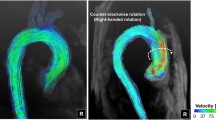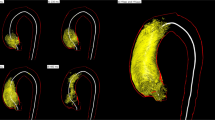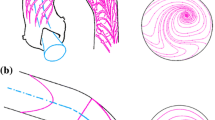Abstract
The mechanics of blood flow in arteries plays a key role in the health of individuals. In this framework, the role played by the presence of helical flow in the human aorta is still not clear in its relation to physiology and pathology. We report here a method for quantifying helical flow in vivo employing time-resolved cine phase contrast magnetic resonance imaging to obtain the complete spatio-temporal description of the three-dimensional pulsatile blood flow patterns in aorta. The method is applied to data of one healthy volunteer. Particle traces were calculated from velocity data: to them we applied a Lagrangian-based method for helical flow quantification, the Helical Flow Index, which has been developed and evaluated in silico in order to reveal global organization of blood flow. Our results: (i) put in evidence that the systolic hemodynamics in aorta is characterized by an evolving helical flow (we quantified a 24% difference in terms of the content of helicity in the streaming blood, between mid and early systole); (ii) indicate that in the first part of the systole helicity is ascrivable mainly to the asymmetry of blood flow in the left ventricle, joined with the laterality of the aorta. In conclusion, this study shows that the quantification of helical blood flow in vivo is feasible, and it might allow detection of anomalies in the expected physiological development of helical flow in aorta and accordingly, could be used in a diagnostic/prognostic index for clinical practice.









Similar content being viewed by others
References
Baciewicz F. A., D. G. Penney, W. A. Marinelli, R. Marinelli. Torsional ventricular motion and rotary blood flow. What is the clinical significance. Cardiac Chronicle 5, 1–8, 1991
Belian A., O. Chkhetiani, E. Golbraikh, S. Moiseev. (1998) Helical turbulence: turbulent viscosity and instability of the second moments. Physica A 258(1–2), 55–68
Bellhouse B. J., L. Talbot. (1969) The fluid mechanics of die aortic valve. J. Fluid Mech. 35:721–736
Bogren H. G., R. H. Klipstein, D. N. Firmin, S. R. Underwood, D. B. Longmore. (1989) Quantitation of antegrade and retrograde blood flow in the human aorta by magnetic resonance. Am. Heart J. 117, 1214–1222
Buonocore M. H., H. G. Bogren. (1999) Analysis of fow patterns using MRI. Int. J. Card. Imaging 15, 99–103
Caro C. G., D. J. Doorly, M. Tarnawski, K. T. Scott, Q. Long, C. L. Dumoulin. (1996) Non-planar curvature and branching of arteries and non-planar-type flow. Proc. R. Soc. Lond. A 452, 185–197
Chandran K. B. (1993) Flow dynamics in the human aorta. J. Biomech. Eng. 115, 611–616
Chandran K. B., W. M. Swanson, D. N. Ghista, H. W. Vayo. (1974) Oscillatory flow in thin-walled curved elastic tubes. Ann. Biomed. Eng. 2(4), 392–412
Chandran, K. B., and T. L. Yearwood. Experimental study of physiological pulsatile flow in a curved tube. J. Fluid Mech. 111:59–85, 1981
Chandran K. B., T. L. Yearwood, D. W. Wieting. (1979) An experimental study of pulsatile flow in a curved tube. J. Biomech. 12(10), 793–805
Darmofal D. L., R. Haimes. (1996) An analysis of 3D particle path integration algorithms. J. Comput. Phys. 123(1), 182–195
David, L., A. Esnault, and D. Calluaud. (2002) Comparison of techniques of interpolation for 2D and 3D velocimetry. In: Proceedings of the Eleventh International Symposium on Applications of Laser Techniques to Fluid Mechanics, Lisbon. Instituto Superior Técnico, Lisbon
Dean W. R. (1927) Note on the motion of a curved pipe. Philos. Mag. 7(4), 208–223
Farthing S., P. Peronneau. (1979) Flow in die thoracic aorta. Cardiovasc. Res. 13, 607–620
Firmin D., J. Keegan. (2001) Navigator echoes in cardiac magnetic resonance. J. Cardiovasc. Magn. Reson. 3(3), 183–193
Fogel M. A., P. M. Weinberg, A. K. Hoydu Anne, M. Hubbard, J. Rychik, M. L. Jacobs, K. E. Fellows, J. Haselgrove. (1997) Effect of surgical reconstruction on flow profiles in the aorta using magnetic resonance blood tagging. Ann. Thorac. Surg. 63, 1691–1700
Frazin L. J., G. Lanza, M. Vonesh, F. Khasho, C. Spitzzeri, S. McGee, D. Mehlman, K. B. Chandran, J. Talano, D. McPherson. (1990) Functional chiral asymmetry in descending thoracic aorta. Circulation 82(6), 1985–1994
Frydrychowicz A., R. Arnold, A. Harloff, C. Schlensak, J. Hennig, M. Langer, M. Markl. (2008) Images in cardiovascular medicine. In vivo 3-dimensional flow connectivity mapping after extracardiac total cavopulmonary connection. Circulation 118(2):e16–17
Frydrychowicz A., R. Arnold, D. Hirtler, C. Schlensak, A. F. Stalder, J. Hennig, M. Langer, M. Markl. (2008) Multidirectional flow analysis by cardiovascular magnetic resonance in aneurysm development following repair of aortic coarctation. J. Cardiovasc. Magn. Reson., 8–10(1):30
Frydrychowicz A., A. Berger, M. F. Russe, A. F. Stalder, A. Harloff, S. Dittrich, J. Hennig, M. Langer, M. Markl. (2008) Time-resolved magnetic resonance angiography and flow-sensitive 4-dimensional magnetic resonance imaging at 3 Tesla for blood flow and wall shear stress analysis. J. Thorac. Cardiovasc. Surg. 136(2):400–407
Frydrychowicz A., A. Harloff, B. Jung, M. Zaitsev, E. Weigang, T. A. Bley, M. Langer, J. Hennig, M. Markl. (2007) Time-resolved, 3-dimensional magnetic resonance flow analysis at 3 T: visualization of normal and pathological aortic vascular haemodynamics. J. Comput. Assist. Tomogr. 31(1), 9–15
Frydrychowicz A., E. Weigang, A. Harloff, F. Beyersdorf, J. Hennig, M. Langer, M. Markl. (2006) Images in cardiovascular medicine. Time-resolved 3-dimensional magnetic resonance velocity mapping at 3 T reveals drastic changes in flow patterns in a partially thrombosed aortic arch. Circulation 113(11), e460–e461
Frydrychowicz A., E. Weigang, M. Langer, M. Markl. (2006) Flow-sensitive 3D magnetic resonance imaging reveals complex blood flow alterations in aortic Dacron graft repair. Interact. Cardiovasc. Thorac. Surg. 5(4), 340–342
Gharib M., E. Rambod, A. Kheradvar, D. J. Sahn, J. O. Dabiri. (2006) Optimal vortex formation as an index of cardiac health. PNAS 103(16), 6305–6308
Grigioni M., C. Daniele, U. Morbiducci, C. Del Gaudio, G. D’Avenio, A. Balducci, V. Barbaro. (2005) A mathematical description of blood spiral flow in vessels: application to a numerical study of flow in arterial bending. J. Biomech. 38(7), 1375–1386
Hope T. A., M. Markl, L. Wigstrom, M. T. Alley, D. C. Miller, R. J. Herfkens. (2007) Comparison of flow patterns in ascending aortic aneurysms and volunteers using four-dimensional magnetic resonance velocity mapping. J. Magn. Reson. Imaging 26(6), 1471–1479
Kilner P. J., G. Z. Yang, R. H. Mohiaddin, D. N. Firmin, D. B. Longmore. (1993) Helical and retrograde secondary flow patterns in the aortic arch studied by three-directional magnetic resonance velocity mapping. Circulation 88(5 Pt 1), 2235–2247
Kilner P. J., G. Z. Yang, A. J. Wilkes, R. H. Mohiaddin, D. N. Firmin, M. H. Yacoub. (2000) Asymmetric redirection of flow through the heart. Nature 404, 759–761
Ley S., J. Ley-Zaporozhan, K. F. Kreitner, S. Iliyushenko, M. Puderbach, W. Hosch, H. Wenz, J. P. Schenk, H. U. Kauczor. (2007) MR flow measurements for assessment of the pulmonary, systemic and bronchosystemic circulation: impact of different ECG gating methods and breathing schema. Eur. J. Radiol. 61, 124–129
Liepsch D. W. (1986) Flow in tubes and arteries—a comparison. Biorheology 23(4):395–433
Liepsch D. W. (2002) An introduction to biofluid mechanics—basic models and applications. J. Biomech. 35(4), 415–435
Markl M., M. T. Draney, M. D. Hope, J. M. Levin, F. P. Chan, M. T. Alley, N. J. Pelc, R. J. Herfkens. (2004) Time-resolved 3-dimensional velocity mapping in the thoracic aorta: visualization of 3-directional blood flow patterns in healthy volunteers and patients. J. Comput. Assist. Tomogr. 28(4), 459–468
Markl M., M. T. Draney, D. C. Miller, J. M. Levin, E. E. Williamson, N. J. Pelc, D. H. Liang, R. J. Herfkens. (2005) Time-resolved three-dimensional magnetic resonance velocity mapping of aortic flow in healthy volunteers and patients after valve-sparing aortic root replacement. J. Thorac. Cardiovasc. Surg. 130(2), 456–463
Markl M., A. Harloff, D. Föll, M. Langer, J. Hennig, A. Frydrychowicz. (2007) Sclerotic aortic valve: flow-sensitive 4-dimensional magnetic resonance imaging reveals 3 distinct flow-pattern changes. Circulation 116(10), e336–337
Moffatt H. K. (1969) The degree of knottedness of tangled vortex lines. J. Fluid Mech. 36(I):17–29
Moffatt H. K., A. Tsinober. (1992) Helicity in laminar and turbulent flow, Ann. Rev. Fluid Mech. 24, 281–312
Morbiducci U., M. Lemma, R. Ponzini, A. Boi, L. Bondavalli, C. Antona, F. M. Montevecchi, A. Redaelli. (2007) Does flow dynamics of the magnetic vascular coupling for distal anastomosis in coronary artery bypass grafting contribute to the risk of graft failure? Int. J. Artif. Organs 30(7), 628–639
Morbiducci U., R. Ponzini, M. Grigioni, A. Redaelli. (2007) Helical flow as fluid dynamic signature for atherogenesis in aortocoronary bypass. A numeric study. J. Biomech. 40(3), 519–534
Pedley T. J. (1980) The Fluid Mechanics of Large Blood Vessels, Cambridge University Press, Cambridge
Pelc N. J., R. J. Herfkens, A. Shimakawa, D. R. Enzmann. (1991) Phase contrast cine magnetic resonance imaging. Magn. Reson. Q 7(4), 229–254
Seed W. A., N. B. Wood. (1971) Velocity patterns in the aorta Cardiovasc. Res. 5:319–330
Segadal L., K. Matre. (1987) Blood velocity distribution in the human ascending aorta. Circulation 36, 90–100
Steinman D. A. (2000) Simulated pathline visualization of computed periodic blood flow patterns. J. Biomech. 33(5), 623–628
Steinman D. A., C. A. Taylor. (2005) Flow imaging and computing: large artery hemodynamics. Ann. Biomed. Eng. 33(12), 1704–1709
Stonebridge P. A., Brophy C. M. (1991) Spiral laminar flow in arteries? Lancet 338(8779), 1360–1361
Stonebridge P. A., P. R. Hoskins, P. L. Allan, J. F. Belch. (1996) Spiral laminar flow in vivo. Clin. Sci. (Lond.) 91(1), 17–21
Taylor C. A., C. P. Cheng, L. A. Espinosa, B. T. Tang, D. Parker, R. J. Herfkens. (2002) In vivo quantification of blood flow and wall shear stress in the human abdominal aorta during lower limb exercise. Ann. Biomed. Eng. 30(8), 402–408
Tsinober A., E. Levich. (1983) On the helical nature of three dimensional coherent structures in turbulent flows. Phys. Lett. 99A, 321–323
Weigang E., F. A. Kari, F. Beyersdorf, M. Luehr, C. D. Etz, A. Frydrychowicz, A. Harloff, M. Markl. (2008) Flow-sensitive four-dimensional magnetic resonance imaging: flow patterns in ascending aortic aneurysms. Eur. J. Cardiothorac. Surg. 34(1), 11–16
Wigström L., T. Ebbers, A. Fyrenius, M. Karlsson, J. Engvall, B. Wranne, A. F. Bolger. (1999) Particle trace visualization of intracardiac flow using time-resolved 3D phase contrast MRI. Magn. Reson. Med. 41(4), 793–799
Yashiro K., H. Shiratori, H. Hamada. (2007) Haemodynamics determined by a genetic programme govern asymmetric development of the aortic arch. Nature 450(7167), 285–288
Yearwood T. L., K. B. Chandran (1980) Experimental investigation of steady flow through a model of the human aortic arch. J. Biomech. 13(12), 1075–1088
Yearwood T. L., K. B. Chandran. (1982) Physiological pulsatile flow experiments in a model of the human aortic arch. J. Biomech. 15(9), 683–704.
Author information
Authors and Affiliations
Corresponding author
Rights and permissions
About this article
Cite this article
Morbiducci, U., Ponzini, R., Rizzo, G. et al. In Vivo Quantification of Helical Blood Flow in Human Aorta by Time-Resolved Three-Dimensional Cine Phase Contrast Magnetic Resonance Imaging. Ann Biomed Eng 37, 516–531 (2009). https://doi.org/10.1007/s10439-008-9609-6
Received:
Accepted:
Published:
Issue Date:
DOI: https://doi.org/10.1007/s10439-008-9609-6




